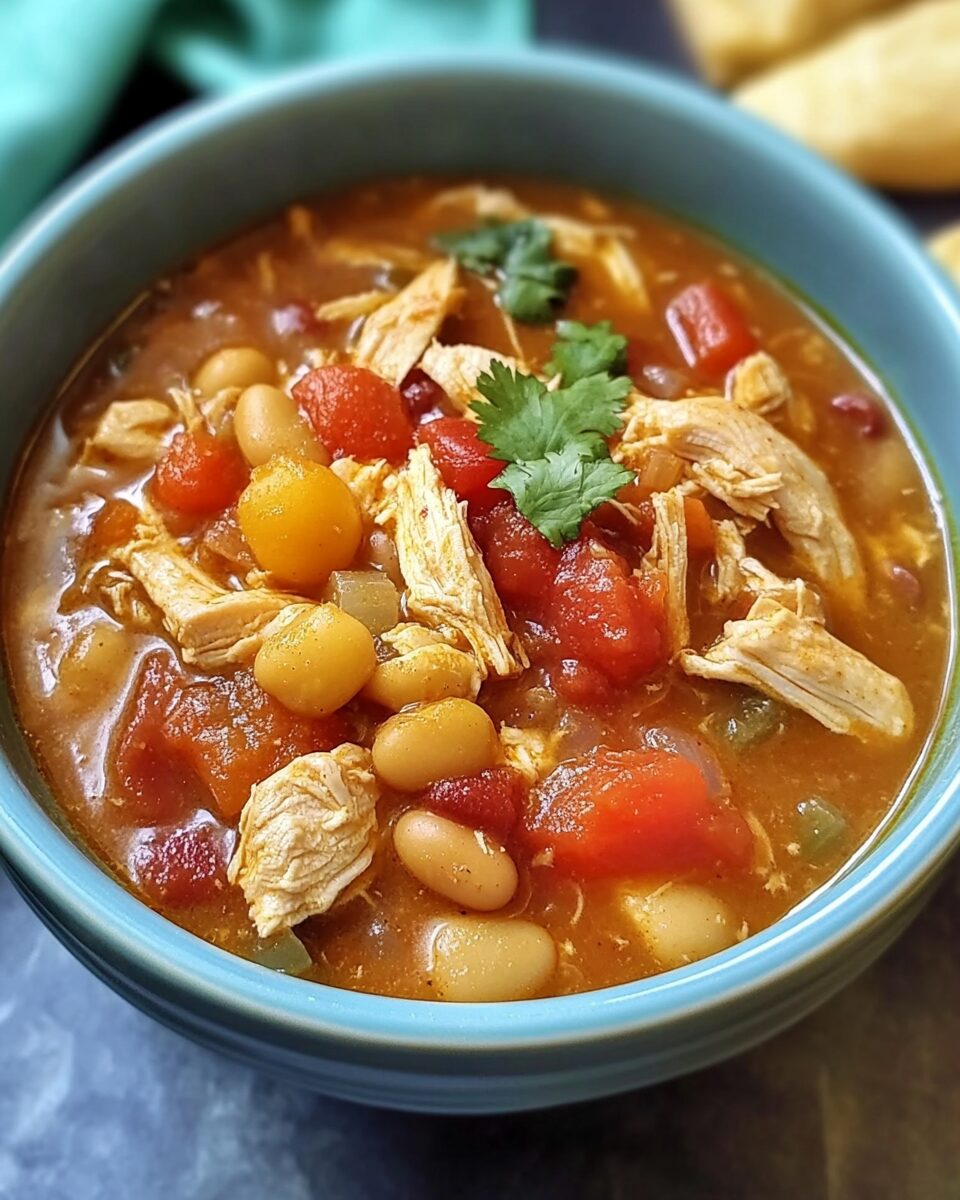Crock Pot Chicken Chili is a hearty and flavorful dish perfect for busy weeknights and casual gatherings. This comforting recipe transforms simple chicken into a robust meal by combining tender chicken breasts with a medley of tomatoes, beans, and vibrant spices that meld together during a slow cook. The result is a deliciously satisfying chili that offers a lighter alternative to traditional beef chili without sacrificing depth or warmth.
Full Recipe:
Ingredients
- 1.5 to 2 pounds boneless, skinless chicken breasts
- 2 (14.5 oz) cans diced tomatoes with their juice
- 1 (8 oz) can tomato sauce
- 1 cup low-sodium chicken broth
- 1 medium onion, diced
- 1 green bell pepper, diced
- 1 red bell pepper, diced
- 2 cloves garlic, minced
- 1 (15 oz) can kidney beans, drained and rinsed
- 1 (15 oz) can black beans, drained and rinsed
- 1 cup frozen corn kernels
- 2 tablespoons chili powder
- 1 teaspoon ground cumin
- 1/2 teaspoon paprika
- Salt and pepper, to taste
- Optional: 1 jalapeño pepper, seeded and minced for extra heat
- Optional: 1/2 teaspoon dried oregano
Directions
Place the chicken breasts at the bottom of your crock pot. Add the diced tomatoes, tomato sauce, and chicken broth over the chicken. Stir in the diced onion, green and red bell peppers, minced garlic, kidney beans, black beans, and corn. Sprinkle the chili powder, cumin, paprika, salt, and pepper evenly over the ingredients; add the optional jalapeño pepper and dried oregano if you prefer extra heat. Stir gently to combine, ensuring that the spices are evenly distributed. Cover the crock pot and cook on low for 6 to 8 hours or on high for 3 to 4 hours, until the chicken is thoroughly cooked and tender. Once done, shred the chicken directly in the pot using two forks and stir well so that all the flavors blend together. Allow the chili to rest for a few minutes before serving.
Nutrients
(Per serving, based on approximately 8 servings)
- Calories: ~220 kcal
- Total Fat: ~4 g
• Saturated Fat: ~1 g - Cholesterol: ~70 mg
- Sodium: ~600 mg
- Carbohydrates: ~30 g
• Dietary Fiber: ~8 g
• Sugars: ~6 g - Protein: ~25 g
History and Cultural Significance
The evolution of chili as a dish is steeped in rich history and cultural significance. Originating in the American Southwest, chili has long been a staple in communities where communal eating and shared recipes are celebrated. Over the decades, various adaptations of chili have emerged, reflecting regional tastes and dietary preferences. The traditional chili, often made with beef and a simple blend of spices, has given way to numerous variations that incorporate different proteins, beans, and flavor profiles. The introduction of chicken as the primary protein in this recipe marks a significant departure from more robust, heavier meat-based versions, offering a leaner and lighter alternative without sacrificing the hearty essence that defines chili. This modern twist not only caters to a health-conscious audience but also pays homage to the dish’s origins, where resourcefulness and flavor were equally valued.
The Art of Slow Cooking
Slow cooking is more than just a method; it is an art form that allows the chef to coax out the full potential of every ingredient. The use of a crock pot in making chicken chili is central to this technique. By cooking at low temperatures over an extended period, the crock pot gently breaks down the chicken, infusing it with the rich, layered flavors of tomatoes, spices, and aromatics. This method of cooking provides several advantages—it tenderizes the meat, creates a complex blend of flavors, and frees up valuable time during the day as the meal cooks unattended. The slow-cooking process is particularly beneficial for melding flavors that might otherwise remain distinct, resulting in a dish where every spoonful carries a balanced mix of heat, tang, and savory goodness. In an era where fast meals often compromise on flavor and texture, slow cooking reminds us of the beauty found in patience and thoughtful preparation.
Flavor Profile and Aromatic Complexity
At the heart of this chicken chili lies a rich and dynamic flavor profile that excites the palate. The interplay of spices such as chili powder, cumin, and paprika creates a warm, inviting base that is both earthy and robust. These spices are carefully chosen not only for their ability to add heat but also for their capacity to enhance the natural flavors of the chicken and tomatoes. Aromatics like onions and garlic, which develop a sweet depth when slowly cooked, serve as the foundation of the dish’s complexity. Over time, the flavors meld together in a way that transforms simple ingredients into a symphony of taste. The resulting aroma is intoxicating—a promise of the comforting meal that awaits. This sensory experience, from the moment the chili begins to simmer to the time it is served, is a testament to the transformative power of slow cooking and the careful balance of spices.
Nutritional Benefits and Health Aspects
One of the standout features of this recipe is its impressive nutritional profile. Chicken is widely regarded as a lean protein that supports muscle repair and overall health, making it a smart choice for those who are mindful of their dietary intake. In addition to protein, the dish includes a medley of tomatoes and beans, which contribute essential vitamins, minerals, and fiber. Tomatoes are known for their high levels of vitamin C, potassium, and the antioxidant lycopene, while beans provide a steady source of dietary fiber that aids in digestion and helps maintain balanced blood sugar levels. The slow-cooking method further preserves these nutrients, ensuring that each serving is as healthful as it is flavorful. By combining lean protein with nutrient-rich vegetables and legumes, this chicken chili offers a balanced meal that not only satisfies hunger but also contributes to overall well-being. It is an excellent example of how comfort food can be both delicious and nutritionally sound.
Customization and Versatility
One of the reasons this chicken chili recipe has become a favorite among home cooks is its remarkable versatility. The basic framework of the dish serves as a blank canvas, inviting cooks to tailor the flavors to their personal taste and dietary requirements. For instance, if you prefer a spicier kick, you can easily introduce additional elements such as diced jalapeños or a dash of cayenne pepper. Conversely, for those who favor a milder flavor, adjusting the quantity of chili powder or experimenting with alternative spices can create a gentler profile. This recipe also lends itself well to seasonal modifications. Incorporating fresh, seasonal vegetables not only boosts the nutritional value of the dish but also adds new layers of flavor and texture. Whether you are in the mood for a traditional version or an innovative twist that reflects your culinary creativity, the adaptable nature of this chicken chili makes it a perfect dish for any occasion.
Practical Tips and Expert Advice
Achieving the perfect chicken chili often comes down to a few practical considerations and expert insights. The key to success lies in the balance of liquid and spices, which must be carefully managed to avoid a dish that is either too watery or overwhelmingly spicy. One valuable tip is to allow the flavors to develop fully by letting the chili simmer slowly, ensuring that the spices have ample time to infuse the chicken and beans. It is also important to monitor the cooking process to prevent overcooking, which could compromise the texture of the chicken. Utilizing a crock pot takes much of the guesswork out of timing, but a gentle reminder is to check the dish periodically if possible. Additionally, allowing the chili to rest for a short period before serving can enhance the melding of flavors, resulting in a more cohesive and satisfying meal. These practical tips, drawn from both tradition and modern culinary practice, ensure that every batch of chicken chili is as consistent as it is delicious.
Serving Suggestions and Enjoyment
The serving experience of chicken chili is as integral to its charm as the cooking process itself. This dish is designed to be shared, making it an excellent choice for family dinners, potlucks, or casual gatherings with friends. The robust flavors of the chili are perfectly complemented by a variety of garnishes and side dishes. Consider topping your bowl with a dollop of sour cream, a sprinkle of shredded cheese, or a handful of freshly chopped cilantro. These additions not only enhance the flavor but also add a pleasing contrast in texture and color. For those who enjoy a bit of crunch with their meal, serving the chili with a side of crispy tortilla chips or warm, crusty bread can elevate the dining experience further. The versatility in serving options means that no two meals are ever exactly alike, inviting creativity and personal expression in how you choose to enjoy this comforting dish.
Community and Family Traditions
Beyond its flavor and nutritional benefits, Crock Pot Chicken Chili holds a special place in the traditions of community and family. Food has always been a central element in bringing people together, and dishes like this chili serve as a focal point for shared experiences and memories. The slow-cooking process, which requires time and care, often becomes a communal activity where family members contribute in small ways—from selecting the perfect blend of spices to sharing in the anticipation of a meal well prepared. Such traditions are passed down through generations, and the simple act of sharing a bowl of chicken chili can evoke feelings of warmth, comfort, and belonging. In many households, the preparation of this dish is not merely a culinary task but a cherished ritual that reinforces family bonds and celebrates the joy of home cooking.
Conclusion
Crock Pot Chicken Chili is more than just a meal; it is a celebration of slow cooking, balanced flavors, and the art of nurturing both body and soul. This dish encapsulates the essence of comfort food by combining lean protein, nutritious vegetables, and a carefully curated blend of spices that develop and harmonize over time. Its rich history and cultural significance, coupled with modern adaptations, have made it a beloved recipe for those seeking a satisfying and healthful meal. The versatility of the dish allows it to be customized to suit various tastes and dietary needs, ensuring that every serving is as unique as the person enjoying it. Practical tips and a thoughtful approach to slow cooking further enhance its appeal, making it an accessible yet refined option for any occasion.






